|
|
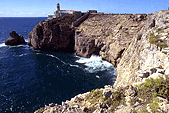 |
ALCOUTIM |
|
| This area is a powerful example of
the life that water brings. The Guadiana River, a natural border
with Spain, breathes life into an otherwise barren part of the
Algarve. Inland, the hills of the Serra are fairly deserted and
could be from another age or planet. But by the river the soil
is alive with forty shades of green, redolent with nature’s
perfume. An enjoyable day’s sightseeing through the narrow streets of Alcoutim will take in the castle that stands on a Roman site and the tall white walls of the Mercy Church. Half a mile outside the city, across the bridge that spans Cadavais Creek, is an old Moorish settlement. These ruins are an unusual reminder of an intelligent, vibrant culture that inhabited this soil yet left little visible remnants to this day. Cap off the day with a cool drink on an esplanade by the water’s edge and a boat trip at sundown. From Faro, follow the A22 east for 32 miles to Vila Real de Santo Antonio and then travel north on the N122 for a further 25 miles to Alcoutim. |
||
|
|
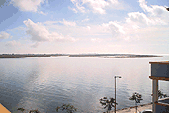 |
VILA REAL DE SANTO ANTONIO |
|
| The frontier town, Vila Real de
Santo Antonio overlooks the Guadiana River to the east, which
separates Portugal from its equally sunny neighbour, Spain. In
the 19th century, the town became a major canning centre because
its waters were laden with sardines and tuna. Colourful fishing boats enrich the sandy beaches with colour. In days gone by boats carried nets out into the sea and fishermen would pull them in by hand from the beach. More developed fishing methods are used today but the fresh fish remains as succulent as ever. In the town centre stands a magnificent obelisk with radiating stone pavements. The Manuel Cabanas Museum of paintings is also worth a visit. It also boasts an ornate church with a famous statue and stained glass windows, fine lace shops and puppet theatres. Incredibly, this town was built in only five months as a show of strength to Spain after the war of 1762-3. From Faro, follow the A22 east for 32 miles to Vila Real de Santo Antonio. |
||
|
|
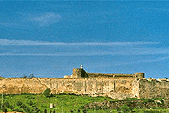 |
CASTRO MARIM |
|
| Like Australia, Castro Marim has
the inauspicious claim to be the place of shelter for refugees
and wanted men up until the 18th century. Linking the church,
the castle and the fort, the streets are lined with typical
Algarve houses – mostly white, with some ochre and blues, and
bright floral and geometrical patterns on the facades. The
castle stands on one hill and the star-shaped fort upon another,
and a river passes by the town. Adjacent to the town lie the salt pans which look like mirrors reflecting the sun and large white pyramids of salt. Visitors are encouraged to tour the pans and learn about century-old salt extraction methods. From Faro, follow the A22 east for 32 miles to Vila Real de Santo Antonio and then travel north west on the N122 for a further 2 ½ miles to Castro Marim. |
||
|
|
 |
TAVIRA |
|
| Tavira is a very attractive city as
it is breached by the Gilao River. Painted boats, palm trees and
benches line the promenade along its banks. Four hundred
year-old houses peer at their reflections in its waters. The
ancient bridge provides a good place to take all this in. Its history is also notable, as it played host to vociferous battles during the reconquest and was in the 15th century the most populous city in the Algarve. Inside the 13th century church lurk the tomb of seven knights killed by a Moorish ambush that triggered the Christian attack. The castle offers a panoramic view of the surrounding area. Do not miss the Church of Mercy, regarded as the finest Renaissance building in the Algarve. The porch is of great beauty. If this does not satisfy the visitor there are over a dozen more churches and chapels dotted around Tavira. From Faro, follow the A22 east for 17 miles to Tavira. |
||
|
|
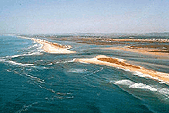 |
OLHAO |
|
| Olhao is an area of the Algarve for
nature lovers. The coastal stretch of beach rises above the land
next to the coast. This produces the phenomenon of inland
lagoons and islands, ideal for swimming and sunbathing. This
geographical rarity also lends itself to fertile land for a
variety of flora, fauna and animal life. Amongst the woodlands,
marshes and pools are many migratory birds and fish. Visitors may also spot a tidal mill, Roman ruins or even a Portugese water-dog, which fisherman once trained to help them in their work. Within the city of Olhao, the fishermen’s quarter and church are worth a visit. It is also a centre for water sport enthusiasts and those taking boat trips to the islands of Armona and Culatra. From Faro, follow the A22 east for 5 ½ miles to Olhao. |
||
|
|
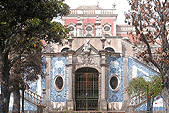 |
ESTOI |
|
| Like many old towns in the Algarve,
Estoi enchants visitors with its whitewashed walls and small
gardens full of trees and flowers. It also has a 16th century
church with well-decorated façade, bell-tower, pulpit,
baptistery and silver treasures. The town is famous, however, for its splendid palace. The romantic tastes of the first owner, an Algarvean nobleman, dictated that the mansion should be built in neo-baroque and neo-rocco style. This was an adventurous departure from the conservative architecture of his time. Enjoy the out-building that houses a nativity scene and the garden statues. The Roman ruins are also worth a visit. In the 3rd century a luxurious villa was built with mosaic floors and columns. On these ruins stands a 16th century house. From Faro, follow the N2 north for 5 ½ miles and then travel east on N2-6 for 1 mile to Estoi. |
||
|
|
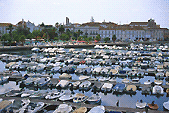 |
FARO |
|
| Capital of the Algarve. Home to the
international airport, University of the Algarve and the
district hospital. The city’s tourist attractions include long
beaches, Farol and Culatra Islands, the Roman ruins at Milreu, a
long artistic heritage and many museums and restaurants. Faro’s old town consists of three distinct areas. The Vila-Adentro area contains the Cathedral, which houses the finest collection of 17th and 18th century art in the Algarve, Episcopal and Italian-influenced buildings, the ramparts and castle, and the archaeological museum. The old Moorish Mouraria quarter houses the Mercy Church built in the style of a Greek cross, the regional museum, city walls and octagonal Granary of St Francis. Finally, the Bairro Ribeirinho has several impressive churches and classical institutional and private houses. The 20th century new town includes luxurious middle class residencies, epitomised by the Palacio Fialho. Faro can be found on our Region Map which is within The Algarve link. |
||
|
|
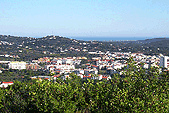 |
SAO BRAS DE ALPORTEL |
|
| This is traditionally the world
centre of cork production and well-decorated buildings remind us
of this former opulence. Inside the main church are gilded 18th
century carvings and 17th century paintings depicting saints. The Antonio Bentes Cultural Centre, once home to a wealthy cork trader, contains typical Algarvean costumes, old carriages and of course corks. The area around Sao Bras De Alportel is worth a visit for the views, flowers, Pousada Hotel, old hermitages and Fonte Ferrea Picnic Area – but most of all for its tranquillity. From Faro, follow the N2 north for 10½ miles to Sao Bras De Alportel. |
||
|
|
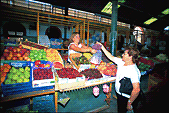 |
LOULE |
|
| The ancient town of Loule is
renowned for its Saturday market and attracts eager bargain
hunters from all over the Algarve. During the rest of the week,
visitors shop in a variety of handicraft stores along the narrow
white streets. Sightseers marvel at the imposing castle on the
spur of a hill. The St Clement Church is also worth a tour as its interior and three side chapels have notable carved and gilded decorations. There are also many other smaller churches and a museum. Special dishes in Loule include hare in white wine, Loule-style chicken (boiled and then fried). Also keep a nose out for goat’s cheese and woodland flower honey brought in from the hills. From Faro, follow the A22 northwest for 4 ¾ miles and then continue on N125-4 for a further 5 ¼ miles to Loule. |
||
|
|
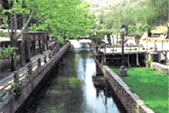 |
ALTE |
|
| On a sun-drenched afternoon in the
Algarve where more refreshing a village to stop off at than
Alte? Its pretty streams and waterfalls cascade down cobbled
streets. Freshly whitewashed walls are crowned by flowery
balconies and delicately laced chimneys. A perfect spot at which
to take lunch. From Albufeira, follow the N595 north for 3 miles and then continue on the N395/N270 for 10 miles to Portela de Messines. At Portela de Messines, proceed east on N124 for 4 ¾ miles to Alte. |
||
|
|
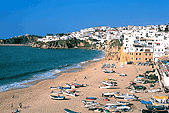 |
ALBUFEIRA |
|
| Albufeira is a striking collection
of white houses atop an ochre cliff. The city has its fair share
of decorative churches, hermitages and chapels. A symbol of the
new usurping the old is the restaurant that was once the North
gate tower of the city walls. Oblivious to holidaymakers sunning themselves nearby, fishermen go about the millennial old tradition of mending their nets and heading out to sea. A coastal walk reveals the glorious rock formations unique to the area and the pretty cave at Xorino. Revel in the thriving nightclub scene in Albufeira or leave it behind for one of the area’s serene inland villages. Albufeira can be found on our Region Map which is within The Algarve link. |
||
|
|
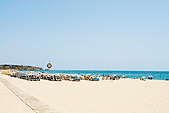 |
ALVOR |
|
Alvor was an ancient coastal village in Portugal and is now a very popular holiday location in The Algarve. Many of the streets boast bars with live music and different types of restaurants but leading off from these there are still memories of the older fishing village. Alvor is a well located village for a villa holiday, facing a natural lagoon opening onto the sea. There is a choice of a long open sandy beach or a number of small coves tucked under the cliffs. The attractive 16th century parish church is worth a visit on your holiday and is one of the only buildings to survive the earthquake of 1755 and is a prime example of the Manueline era of architecture. Near to Alvor are the commercial town of Portimão, the famous popular beach of Praia da Rocha and Praia da Vau, and the semi-nature reserve of Quinta da Rocha. Ferragudo, just over the Rio Arade to the east, is a fishing village with good restaurants, a lovely beach and pretty harbour outside of the town. Portimão faces Ferragudo, on the other side of the Rio Arade estuary - one of the Algarve's largest towns, with its monthly market, commercial centre, shops and restaurants. Its splendid new marina, at the mouth of the River Arade across from Ferragudo, adjoins the bustling holiday resort of Praia da Rocha, with a huge beach, bars, clubs and entertainment. The popular holiday resort of Carvoeiro is about 17kms east; also a fishing village with a small beach, and nowadays a popular Algarve resort with shops, restaurants and bars. Lagos is about 18kms a charming historic town with a stylish modern marina, a shopping area, restaurants, bars, cafés and shops, and some nightlife venues in summer. |
||
|
|
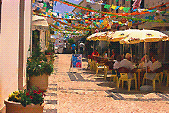 |
SILVES |
|
| As if paying tribute to a turbulent
history in the middle ages, the blood red walls of mighty Silves
Castle overlook the surrounding countryside. The largest
military monument to the Islamic period in Portugal, it
remembers a different past in the Iberian Peninsula. The Old Cathedral (which features gargoyles from over 500 years ago) city walls and medieval bridge emphasise Silves as an historical town. An historical town would be incomplete without a museum, which in this city contains an 11th century well! Visitors may wish to take a trip through time by sailing down the Arade River to the sea, passing vestiges of Roman and Viking presence. Silves can be found on our Region Map which is within The Algarve link. |
||
|
|
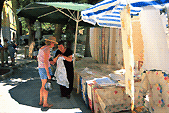 |
LAGOA |
|
| Lagoan people are very skilled in
crafting decorations from natural materials. Women can be seen
weaving dwarf palm into hats, rugs and mats. The men make
baskets from reeds. Copperware and ceramics are also popular
products. The Algarve’s largest craft show takes place in August each year in Lagoa, the province’s craft capital. A stroll around the hilltop town reveals a labyrinth of whitewashed houses, windows edged in blue, Manueline doorways and the imposing turret of the monastery. At the entrance to the monastery is an 'outcasts hatch' once used for receiving abandoned children. In the garden is a stone menhir dating from 4,000 BC. Lagoa can be found on our Region Map which is within The Algarve link. |
||
|
|
 |
PORTIMAO |
|
| The second most populous city in
the Algarve, Portimao is crowned by a fetching white church on a
hilltop. Marvel its impressive gargoyle, buttresses, high naves
and altar. The city is further characterised by the narrow
streets. Visit the old fishermen and tradesmen quarter, and its immense beach Praia da Rocha. The local delicacy, grilled sardine served on a slice of homemade bread, can be had in any of the quayside restaurants. Sample the Portimao-style clams, razor clam risotto and whelk stew to really let your taste buds embrace the Algarve. Relax in the shade of the Manueal Bivar gardens and soak up the architecture and slow pace of life. Portimao can be found on our Region Map which is within The Algarve link. |
||
|
|
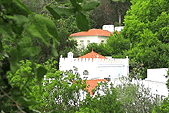 |
CALDAS DE MONCHIQUE |
|
| News has been spreading fast about
the healing powers of the spa waters of Caldas de Monchique.
This little market hamlet is beginning to thrive on the
therapeutic qualities of its waters and bars, restaurants and
hotels are springing up. The Romans adored its 32’C slightly sulphurous waters. The spas beside, there is plenty to do in the vicinity: mountain biking, hiking and horse-riding tours are available. Restaurants across the Algarve, and especially here, serve frango pira-pira. This spicy condiment mixed with roast chicken will give you a taste of Africa, from where it came. From Silves proceed west on N124 for 6 ½ miles and then continue north west on N266 for 13 miles to Caldas de Monchique. |
||
|
|
 |
MONCHIQUE |
|
| Away from the heat and the crowds,
the freshness of the Monchique hills is most tangible. This area
of the Algarve is blessed with fertile rolling hills, shrouded
in flowers and outcropped boulders, ideal for walking. Betwixt the whitewashed houses of this hill town stand three churches, each housing impressive carving and sculpture. Most notable is the porch of the Igreja Matriz with its twisted stone columns. A breathtaking view of Monchique can be enjoyed from the ruins of the Nossa Senhora de Desterro Monastery. The monastery gardens are decorated with tiles showing birds and a magnolia tree that may be the biggest in Europe. Arbutus trees, from which derives a strong brandy, are also found in this area. From Silves proceed west on N124 for 6 ½ miles and then continue north west on N266 for 13 miles to Caldas de Monchique. Continue past Caldas de Monchique for 3¼ miles to Monchique. |
||
|
|
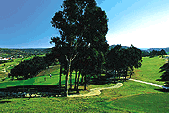 |
PARQUE DE FLORESTA GOLF COURSE |
|
| This challenging course with its
dramatic scenery lies amongst gently rolling hills. It features
a number of short holes such as the 120-yard 5th, which has a
green sloping away on all sides. The 9th and 15th holes are tough, with the 9th described as one of the most difficult holes in Europe. Prepare for a drive over a Portuguese garden and a third shot over a creek to a plateau. Success at the par three 15th requires a tee shot across a chasm to a well-bunkered green. Guests can use the tennis courts, lawn bowling green, gym, outdoor pool and nature trails. Address: Vale do Poao, Budens, 8650 Vila do Bispo Tel: 289 695 333 Fax: 289 695 157 Description: Eighteen holes, 5670 metres, Par 72 Designer: Pepe Gancedo Location: Between Budens and the Sagres turn-off on the EN125. |
||
|
|
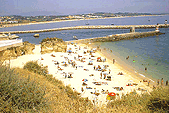 |
LAGOS |
|
| Lagos had its hey day in the 15th
century when wealthy merchants and bankers built sumptuous
houses with the ivory, gold and silver that returned on boats
from Africa. This walled city was levelled in 1755 by an
earthquake and a tidal wave that followed. Today it is a
bustling city proud of its past. City sites include the churches of Santo Antonio, Sao Sebastiao, Santa Maria, Nossa Senhora, the 15th century slave market, the panoramic views from the walls and the museum. Local delicacies include Dom Rodgigos, a cake favoured by nuns at the Convent of Our Lady Carmel. Local crafts include pottery, copperware and textiles. Lagos can be found on our Region Map which is within The Algarve link. |
||
|
|
 |
SALEMA |
|
| Ten and a half miles from Lagos,
Salema is set on a wide attractive bay. The town has a very easy-going atmosphere, having avoided over development, and is close to several small secluded beaches – namely, Praia de Salema, Praia da Figueira and Boca do Rio. Overlooking the Praia de Salema is the popular Restaurante Atlantico, offering a sumptuous variety of fish dishes. Salema can be found on our Region Map which is within The Algarve link. |
||
|
|
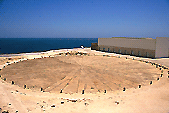 |
SAGRES |
|
| Established by Prince Henry the
Navigator as town from which to discover the world, Sagres sits
at the helm of Europe. Surrounded by sea on three sides and
whipped by fierce winds, its cliffs and fortifications present
an austere landscape to visitors. Christopher Columbus studied at the School of Navigation, perhaps tossing stones into the sea, dreaming of foreign lands. Not so intimidating for Sir Francis Drake, it seems, who in 1587 captured and wrecked the defences! Fair skinned folk make a note of the cooler climate in Sagres than elsewhere in the Algarve. Sagres can be found on our Region Map which is within The Algarve link. |
||
|
|
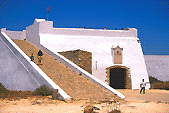 |
SAGRES THE FORT |
|
| Known locally as Fortaleza de
Sagres, the fort in its present form dates from 1793. Just
inside the gate to the impressive building is a 141 foot wind
rose for measuring the direction of the wind, excavated in the
18th century. As with many ruins, building has taken place on
top of the original stonework throughout the centuries. In this
case until as late as the 1950s in preparation for the 500th
anniversary of Prince Henry’s death and beyond. For example, you will find a very old church and lighthouse near a modern museum hall. The fort is open daily between May and September. |
||
|
|
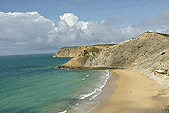 |
VILA DO BISPO |
|
| This is a town where the history of
the Algarve can be appreciated in full. Stone menhirs have stood
in this south western area of the Algarve in testament to the
Palaeolithic period when Europe was joined to Africa. Today a church tower rises high above the whitewashed houses that make up the town. The church itself contains some beautiful 16th to 18th century paintings and tiles, and is surrounded by a pretty old quarter. It is said that the Hermitage of Nossa Senhora de Guagalupe was a place of prayer for the great conquistador, Prince Henry the Navigator. |
||
|
|
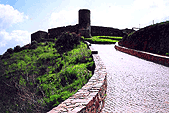 |
ALJEZUR |
|
| This region houses the Costa
Vicentina Natural Park, which covers 50 miles of coastline. It
is vibrant with wild animals and verdant with flowers. While
walking in the fields near Rogil visitors can pick up a peanut
– the fertile soil cultivates unusual edible peanuts and sweet
potatoes! The west-facing beaches are surrounded by tall cliffs
and offer excellent fishing and a sense of isolation. The town of Aljezur is crowned by a castle that overlooks the creek and offers a panoramic view of the surrounding area. There is also a pillory, where criminals were once exposed to public scorn, and the Church of Mercy, where presumably they were redeemed. Elsewhere, the Main Church houses treasures such as a Eucharist box encrusted with mother-of-pearl. Also keep a look out for the Fountain of Lies, which has an interesting story behind it. From Vila do Bispo, proceed north on N268 for 15½ miles, then continue on N120 for a further 4½ miles to Aljezur. |
||
|
|
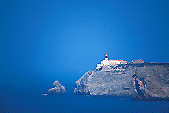 |
CABO DE SAO VICENTE |
|
| Cape St Vincent is Europe’s
south-western most point. Next stop Rio de Janeiro. A barren
place that would have left sailors with a sense of foreboding as
it past their starboard side on the way out into the Atlantic.
The cape derives its names from the name of a Spanish priest
killed by the Romans in 304 AD. His body lies in the church in
the fort and the ravens that followed him as he was transported
here by boat for burial have been sanctified on Sagres’s coat of arms. Another story says Vincent was an Italian martyr washed up on the rocks here. The cape is a stunning three and three quarter miles cliff top walk from Sagres, passing restaurants en route. Not a bad sunset when you get there either... If the lighthouse is open you can climb up the spiral staircase to see the prisms and the 3000-watt bulb. The lighthouse is one of the most powerful in Europe, casting its light some 60 miles out into the Atlantic. |
||
|
|
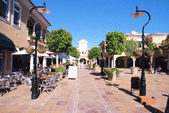 |
VALE DO LOBO |
|
| This area of the Algarve is
internationally famed for its exclusivity. A playground for the
rich and famous, luxurious villas are dotted around like jewels. The resorts are very well kept and provide visitors with every facility imaginable, all of which have been developed in recent years on the coast amongst pinewoods and long sandy beaches. Villas are hidden between abundant trees without detracting from the area’s natural tranquillity, but still close to local activities. Water sports are excellently catered for with everything from deep-sea fishing to banana boating on offer. Special centres such as the one on Quinta do Lago lake provide equipment, lessons and excursions. Golf courses in the area are of such a high standard that they have become household names. Vale do Lobo, Quinta do Lago, Pinheiros dos Altos and the superb San Lorenzo are a delight for any golfer. There is also a squash and health club in the vicinity, which includes tennis and horse riding. |
||
|
|
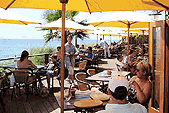 |
VALE DO LOBO |
|
Vale do Lobo, and Quinta do Lago, are two exclusive resorts located in the Algarve in the south of Portugal between Faro and Quarteira which have developed among the pinewoods above the glorious, long sandy beaches of this area. Approximately 20 minutes transfer from Faro airport, Vale do Lobo and Quinta do Lago have numerous luxurious villas and holiday developments which have gained the resorts international renown. At Vale do Lobo you can find boutiques, designer jewellery, art gallery,restaurants overlooking the beach and nightclubs. Quinta do Lago offers 'Quinta Shopping' where you can find nouvelle cuisine restaurants and designer shops. Vale do Lobo and Quinta do Lago are great places for a golfing villa holiday with several excellent championship golf courses such as Vale do Lobo, Quinta do Lago, Pinheiros Altos, the superb San Lorenzo and also home to The Royal Golf Course and The Ocean Golf Course. The Ocean Golf Course is situated almost on the beach, with views of the ocean and The Royal Golf Course is amongst pine tress and lakes with beautiful coastal views. Tee off times can be arranged by calling the clubs in advance. There is a squash and health club, tennis and horse riding facilities and a watersports centre on the lake at Quinta do Lago. The area, whilst containing a number of holiday developments, remains low key and low rise. The villas and accommodation in this area are all interspersed with an abundance of pine trees, carefully hiding much of the available accommodation. This peaceful Algarve setting, close though it is to so much sport and leisure activity, has a slightly rural and gentler feel. It does, however, have its share of good nightclubs, as well as restaurants to suit all tastes and all wallets. Nearby, the small crossroads town of Almancil has an excellent range of facilities with many shops and cafes. |
||
|
|
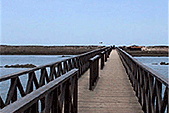 |
QUINTA DO LAGO |
|
Vale do Lobo, and Quinta do Lago, are two exclusive resorts located in The Algarve in the south of Portugal between Faro and Quarteira which have developed among the pinewoods above the glorious, long sandy beaches of this area. Approximately 20 minutes transfer from Faro airport, Vale do Lobo and Quinta do Lago have numerous luxurious villas and holiday developments which have gained the resorts international renown. At Vale do Lobo you can find boutiques, designer jewellery, art gallery, restaurants overlooking the beach and nightclubs. Quinta do Lago offers 'Quinta Shopping' where you can find nouvelle cuisine restaurants and designer shops. Vale do Lobo and Quinta do Lago are great holiday resorts for a golfing villa holiday with several excellent championship golf courses such as Vale do Lobo, Quinta do Lago, Pinheiros Altos, the superb San Lorenzo and also home to The Royal Golf Course and The Ocean Golf Course. The Ocean Golf Course is situated almost on the beach, with views of the ocean and The Royal Golf Course is amongst pine tress and lakes with beautiful coastal views. Tee off times can be arranged by calling the clubs in advance. There is a squash and health club, tennis and horse riding facilities and a watersports centre on the lake at Quinta do Lago. The area, whilst containing a number of holiday developments, remains low key and low rise. The villas and accommodation in this area are all interspersed with an abundance of pine trees, carefully hiding much of the available accommodation. This peaceful Algarve setting, close though it is to so much sport and leisure activity has a slightly rural and gentler feel. It does, however, have its share of good nightclubs, as well as restaurants to suit all tastes and all wallets. Nearby, the small crossroads town of Almancil has an excellent range of facilities with many shops and cafes. |
||
|
|
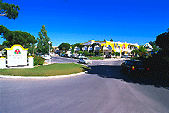 |
BUGANVILIA PLAZA |
|
| Situated at the end of Vale do Lobo
and before the entrance to Quinta do Lago, Buganvilia Plaza shopping complex includes boutiques, coffee shops, restaurants, bars and a sizeable supermarket. |
||
|
|
 |
QUINTA SHOPPING CENTRE |
|
| Adjacent to Buganvilia Plaza, the
exclusive Quinta Shoppping Centre has a vast range of designer
shops and luxury restaurants as well as the Melting Pot pub. |
||
|
|
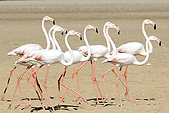 |
RIA FORMOSA NATURE PARK |
|
| This vast protected area covers
some 71 square miles. It was established to preserve the natural
resources on which the local population depend for most of their
traditional activities, such as fish and shellfish farming,
traditional fishing and salt production. Amongst other natural attractions, the nature park is home to wetlands, indigenous fauna and flora and migratory species. |
||
|
|
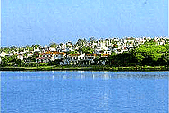 |
ALMANCIL |
|
A gateway to some of the most interesting coastline of The Algarve, Olhos de Agua is a small quaint holiday resort with an abundance of restaurants, bars, cafes, local handicraft/souvenir stores hugging the winding road that leads down to the great family beach. Olhos de Agua is an ideal location in Portugal for those wanting a quieter holiday in The Algarve, with a more relaxed pace of life, in beautiful surroundings. The name Olhos de Agua derives its name from the ‘eyes of water’ that flow from strangely formed rocks, visible only at low tide. Fishermen still launch their colourful boats from its pretty cove beach. and repair their nets on the sea wall. Olhos de Agua is signposted along the main Albufeira to Quarteira road and is also signposted from Falesia. |
||
|
|
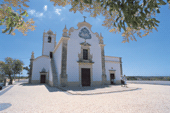 |
THE CHURCH OF SAINT LAWRENCE OF ALMANCIL |
|
| Known locally as Sao Lourenco do
Matto (Saint Lawrence of the Wood), the church stands on a small
hill overlooking the main EN125 road 16 kilometres west of Faro.
Inside is one of the world’s finest displays of design.
Azulejos (pronounced ah-zoo-lay-zhoos) are hand-painted, glazed
ceramic tiles introduced by the Moors. Every square inch of this 15th century baroque church is covered in these hand-painted blue and white ceramic tiles, including the walls, ceiling and cupola. Most date from the 18th century and depict biblical scenes detailing the life of Saint Lawrence. The only thing not blue and white is the carved, gilded alter. The church is open Tuesday to Saturday 10am to 1pm and 2.30pm to 6pm, and Monday 2.30pm to 6pm, admission free. |
||
|
|
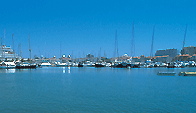 |
VILAMOURA MARINA |
|
| This modern marina offers
everything a yachtsman might want. In terms of services and
facilities it is second to none. Once a Roman harbour, it is a
fascinating place to walk around. Stop off for lunch at one of
the many cafes and visit the large commercial centre with two
levels of shops, restaurants and bars. |
||
|
|
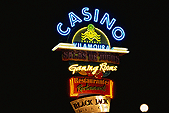 |
VILAMOURA CASINO |
|
| This internationally famous casino promises a fantastic night out. Try your luck at one of the numerous gaming tables, the one-armed bandits or in the bingo rooms. The casino’s vast restaurant, which accommodates 500 people, features a nightly floor show. | ||
|
|
 |
CERRO DA VILA (ROMAN ARCHAEOLOGICAL SITE |
|
| In 1963 an archaeologist made an
exciting find on the northern side of the marina when fragments
of Roman mosaic were spied in the soil. The spot turned out to
be the remains of Cerro da Vila, where Romans, Visigoths and
Moors all left their mark. Take a look at the water piping
system and the surviving mosaics and enjoy the museum containing
coins, vases and other artefacts uncovered here. |
||
|
|
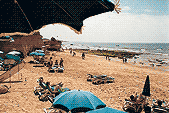 |
OLHOS D’AGUA |
|
A gateway to some of the most interesting coastline of The Algarve, Olhos de Agua is a small quaint holiday resort with an abundance of restaurants, bars, cafes, local handicraft/souvenir stores hugging the winding road that leads down to the great family beach. Olhos de Agua is an ideal location in Portugal for those wanting a quieter holiday in The Algarve, with a more relaxed pace of life, in beautiful surroundings. The name Olhos de Agua derives its name from the ‘eyes of water’ that flow from strangely formed rocks, visible only at low tide. Fishermen still launch their colourful boats from its pretty cove beach. and repair their nets on the sea wall. Olhos de Agua is signposted along the main Albufeira to Quarteira road and is also signposted from Falesia. |
||
|
|
 |
PRAIA DA OURA/MONTECHORO |
|
Praia d'Oura in The Algarve is approximately two miles east of Albufeira. Not many years ago Praia d'Oura did not exist as a holiday resort, but nowadays it is not so much a spin-off of Albufeira but is a thriving resort in Portugal in its own right providing a good range of shops, , bars and nightclubs. Several of these can be found along the lively area known as "The Strip". For those that want a bustling atmosphere on their villa holiday, Praia d'Oura has many market stalls along its streets. At the end of "The Strip" a steepish hill leads down to Praia Da Oura's well known "Golden Beach" with a wonderful expanse of golden sands. Praia d'Oura is a perfect choice for a holiday for relaxing on the beach or enjoying the watersports such as windsurfing, water-skiing, jet skis and a banana boat ride along Praia d'Oura's "Golden Beach". For those that like walking, Albufeira can be reached along the coast. Praia d'Oura is a suitable holiday resort for all ages especially the young at heart with its varied night life. The older part of Albufeira is ideal to get a taste of the past; narrow streets, handicraft shops and traditional Algarvean colours. There are wide shopping streets and a lively atmosphere particularly in the large redesigned and repaved square with live music featuring at times, contributing to this modern Algarve holiday resort. It also boasts a beautiful and expansive sandy beach, flanked by dramatic cliffs and rock formations. If you want more relaxing surroundings on your Algarve villa holiday, a string of picturesque cove beaches can be found just to the west of Albufeira, such as Coelho, Castelo and Gale. Between the resorts of Praia d'Oura and Albufeira is Forte Sao Joao, a pleasant smaller resort with a good sandy beach. |
||
|
|
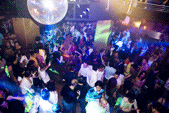 |
KISS DISCO |
|
| Wet your lips for this the most
famous disco in Portugal. Established 15 years ago, it has built
up a reputation for wild extravagance and an international
clientele. Male strippers by the name of the Coconut Cascais are
also on the bill regularly. Kiss Disco is situated near Praia
d’Ouro, just past Jacaranda (Tel 028 515 639). |
||
|
|
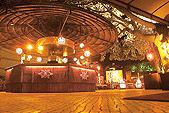 |
DISCO BAR LIBERTOS |
|
| With esplanade, swimming pool and
giant screen, Libertos is a favourite super-club for Portugese footballers. Offering all-night dancing, excellent cocktails and light meals, it is a full-on experience. Every Wednesday 'Games Without Frontiers' are held at the poolside – obviously a liberal club that lives up to its name! The disco is located in Areias de San Joao, 8200 Albufeira. |
||
|
|
 |
KADOC |
|
| With a name that is difficult to
translate and probably better left that way, Kadoc is one of the
most popular discos in the Algarve and a particular favourite of
the younger generation. The disco is located between Albufeira
and Vilamoura. |
||
|
|
DISCOTECA LOCOMIA |
||
| One of the largest in the Algarve
and popular with twenty-somethings, this disco promises to be
just what it says on the tin – loco. It has esplanades with
breathtaking views of the sea, the night sky and later of course
the dawn. Open daily during the summer season from midnight until 6am, Locomia is located on Praia de Santa Eulalia, 82200 Albufeira. |
||
|
|
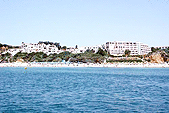 |
FORTE SAO JOAO |
|
Fort Sao Joao is a pleasant small holiday resort in The Algarve with a good sandy beach, between the resorts of Praia d'Oura and Albufeira. The Fort of Sao Joao de Arade started life in the 15th century as a lookout tower and was extended in the 17th and 18th century. Today it is private property and was turned into a home on the initiative of the poet, Coelho Carvalho. The remains of Atalaia and Quinta da Torre can be seen in the area which were medieval watchtowers used to give warning of attacks by pirates. |
||
|
|
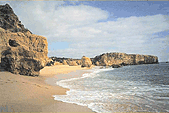 |
SAO RAFAEL, CASTELO, GALE, VALE DE PARRA |
|
Leave Albufeira for Sao Rafael and you also leave the built-up busy city. Sao Rafael and Castelo are in stark contrast to the larger Algarve resorts. With no high-rise developments and bustling streets, visitors are free to indulge in the natural beauty of The Algarve. Head west from Albufeira and you will find an altogether different Algarve as you leave the bright lights and crowds of tourists behind and enter a place noted for its peace and serenity. The restaurants are family orientated, with children always welcome, and needless to say there are some wonderful beach restaurants offering excellent lunchtime or early evening menus including sardines, salads, locally caught fish and grilled meats – perfect with a chilled bottle of Vinho Verde. Some of the beaches have rock pools, which children can spend hours exploring, or observing the marine life left behind when the tide goes out. A number, such as Sao Rafael and , have a small selection of water sports facilities. |
||
|
|
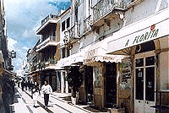 |
GUIA |
|
Guia is a small village in The Algarve some 3 miles inland from Albufeira. The narrow streets and old-style cottages are reminders of Portugal in times gone by, and yet with a ten minute drive are the attractive cove bays, rock pools and the sandy beaches of , Castelo and Sao Rafael, all with snack bars/restaurants. Famous for its wonderful eating experience, numerous restaurants and hospitable restaurateurs, Guia is known as the chicken piri piri (a traditional spiced chicken dish) capital of The Algarve. Guia also has a good selection of restaurants offering a wider menu range including international dishes. For those looking for a lively night life on their holiday in The Algarve, visit Albufeira and on the far side, the thriving nightlife of Montechoro and Praia d'Oura. 4 miles to the south-west is Armacao de Pera, a quieter Algarve town, also boasting an impressive large beach. For children there is plenty to do on holiday, visit the water-slide park and the Zoomarine Aquarium and dolphin show.
|
||
|
|
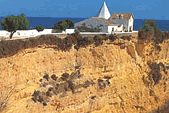 |
ARMACAO DE PERA |
|
Armacao de Pera was until recent times a tiny fishing village and even though there's been rapid growth in the area, the core of Armacao de Pera is still made up of quaint fishermen's cottages. In fact the catch is still landed here from the brightly painted fishing boats you'll see by the water and there's a daily fish market by the beach and a number of fish restaurants. This popular Algarve resort offers a wide selection of shops, bars and restaurants as well as a beautiful beach and various water sports. Armacao de Pera has a small fortress dating back to 1760, which contains a pretty chapel and worth a visit on your villa holiday. The town has an attractive esplanade on the front and Armacao de Pera Beach is one of the longest in the whole of The Algarve. You will find golden sand that stretches all the way to Galé Beach near Albufeira – the energetic can walk there! Gently shelving, the sands are perfect for families with young children and there's easy access. Excursions by boat to explore the caves along The Algarve coastline are available from the beaches. Further east at Galé, towards Albufeira, there is water-skiing and wind-surfing, with pedalos and banana boats for hire. Some 2½ miles away from here is the golf course of Salgados, with its lovely sea views. One of the largest water parks on The Algarve, is Aqualand, which is 3½ miles, just outside Alcantarilha, another pretty old Algarve town. Guia itself, the renowned home of the typical Algarve dish, spicy chicken piri-piri, is around 4 miles away. Eastwards, beyond , is Algarve Shopping, a large commercial centre with shops and restaurants, as well as a multi-screen cinema complex and a ten-pin bowling centre. Inland is the city of Silves, a historic Moorish capital of the region with a castle, museum and cathedral and interesting side streets.
|
||
|
|
 |
CARVOEIRO |
|
Carvoeiro is a coastal resort in The Algarve, Portugal, lying some three miles south of Lagoa and is typical of this stretch of the coastline with its dramatic cliffs and white villas perched above. Fishing boats line the beach and the fish enjoyed in the restaurants are still landed here by the local fishermen. The main beach, although small, is very attractive and Carvoeiro's and bars are centred around it. Carvoeiro is a good, family resort for a villa rental, but also has its share of nightlife for those seeking it on their holiday. The area is rich in dramatic and beautiful beach with intimate coves backed by high cliffs. Centianes, Carvalho (smugglers beach), Benagil, Marinha to the east and Aveiros to the west are all attractive beaches, with the cliffs near Algar Seco a must for experienced snorkellers. Ferragudo, further westwards has a long sandy beach with some watersports and there is a large water slide park (Slide and Splash) nearby. Golf is catered for with two good courses. Several activities within driving distance of our Carvoeiro villas can be reached including Rocha Brava Tennis Club, Carvoeiro Clube De Tennis, Vale Do Milho Golf, Vale De Pinta Golf, Ferragudo Water Sports, Praia Da Rocha Bowling, and . |
||
|
|
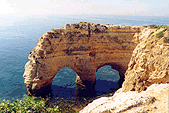 |
ALGAR SECO |
|
| The cliffs, grottoes and rocks of
Algar Seco are the most famous in the Algarve. One kilometre to
the east of Carvoeiro, this geographical wonder is best reached
by local boat. It is also a magical part of the world for avid
snorkellers. Well worth a visit if you are in the vicinity. |
||
|
|
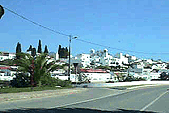 |
ESTOMBAR |
|
The historical centre of Estombar has the appeal and charm typical of towns. Originally, Estombar was a thriving urban centre with an economy built on salt production. This Algarve town lays claim to being the birthplace of a renowned 11th century poet as well as an infamous 19th century guerrilla warfare leader who apparently terrorised the whole of The Algarve |
||
|
|
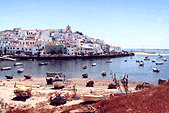 |
FERRAGUDO |
|
Tranquil Ferraguda is well worth a visit on your villa holiday. Despite its proximity to tourist resorts and its two excellent beaches, Ferraguda has managed to avoid commercialization and retains the traditional ambience of an Algarvean fishing village. Ferraguda is a reminder of how unspoilt this part of Portugal was just a few decades ago. Nearby are two fortresses: the Fortaleza de Santa Catarina de Ribamar, built in 1621 to defend this coast of Portugal against the Moors, and the beige-coloured Fortaleza de Ferragudo, which looks like a giant sandcastle. Ferragudo – Praia Grande is a beautiful beach on the River Arade estuary, opposite Portimao harbour, wide and sandy with easy access and beach bar/restaurant. Praia Grande is excellent for all water sports, windsurfers, sailing boats and water skis can be hired from a water sports school. Beyond the pier and lighthouse are more beaches. Portimao faces Ferragudo across the Rio Arade estuary - one of The Algarve's largest towns, with a good pedestrianised shopping area, traditional sardine restaurants by the old bridge, and a new marina with restaurants and bars where you can sample the catch of the day. For nightlife, Praia da Rocha is a bustling holiday resort just beyond Portimao, with a huge beach and all kinds of bars, clubs and entertainment. |
||
|
|
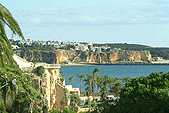 |
PORTIMAO |
|
The bustling town of Portimao faces Ferragudo across the Rio Arade estuary and is one of the largest towns in The Algarve, Portugal and has a lively commercial centre and major fishing port. Portimao has a good pedestrianised shopping area, traditional sardine restaurants by the old bridge, and a new marina with restaurants and bars. Portimao is a town of contrasts, with the ancient and modern living side by side. In the shipyards you’ll find craftsmen still using the same tools that built the Caravelas for the fleet of Dom Henrique and in the town centre of Portimao, modern air conditioned offices. Amongst Portimao's attractions are an eye-catching shopping centre, a number of charming harbour-side cafes and the nearby long, sandy beach of Praia da Rocha. If you are looking for nightlife on your villa holiday, Praia da Rocha is a bustling holiday resort just beyond Portimao with a huge beach and all kinds of bars, clubs and entertainment. Nearby is Alvor, which was an ancient coastal village and is now a very popular holiday location in The Algarve. Many of the streets boast bars with live music and different types of restaurants but leading off from these there are still memories of the older fishing village. Alvor is a well located village for a villa holiday, facing a natural lagoon opening onto the sea. There is a choice of a long open sandy beach or a number of small coves tucked under the cliffs. The attractive 16th century parish church is worth a visit on your holiday and is one of the only buildings to survive the earthquake of 1755 and is a prime example of the Manueline era of architecture. |
||
|
|
 |
LAGOS |
|
The third largest town in The Algarve, Portugal and formerly a walled town, Lagos was the trade centre between Portugal and Africa at the time of the Moorish occupation, and its shipyards built the Caravelas, which sailed the voyages of exploration made by Henry the Navigator's captains. In the old part of Lagos holidaymakers can still see sections of the early Roman walls and admire the ancient fortress which still guards the harbour. A Portuguese fishing town, Lagos fishermen still auction the catch of sardines early in the morning, often entertaining to the British holidaymaker, although the most famous sardine catch along The Algarve coast is in Portimao 18 km east of Lagos. The main beach at Lagos is Meia Praia a 5 mile stretch of golden sand which starts on the eastern side of the railway station. It offers windsurfing, sunbeds and parasols for hire. A string of small beaches on the western side of Lagos , including the picturesque Praia d'Ana, Porto do Mos and Canavial appeal to those who prefer smaller, more intimate coves on their holiday. Some can only be reached by boat or by the famous "cliff walk" which is only recommended for the sure-footed. Lagos has a plethora of pavement side cafes and restaurants offering indoor and outdoor dining, many with good value 'turistic menus' of the day. There is a good selection of boutiques, handicrafts, gift shops and numerous supermarkets, butchers, bakers, etc. There are several activities within the area of Lagos and within driving distance of Lagos to participate in during your Algarve holiday, including Palmares Golf Course, Lagos Water Sports Centre, Lagos Marina, Algarve Microlight Centre, Lagos Zoo, Slide and Splash Waterslide Park, and Zoo Marine. |
||
|
|
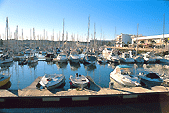 |
LAGOS MARINA |
|
| Your first view of Lagos is often
from the long riverside Avenida dos Descobrimentos, which
divides the old walled city from the port. Across the river is
the marina, where fishermen work on handsome anchored boats.
From here a fabulous view can be had of the city from above its
walls. Visitors can see these mixed Roman and 16th century
ramparts, taking in views of the marina and the sea. Tour operators offer Lagos-Sagres cruises, BBQ cruises, speed cruises, dolphin safaris and grotto trips departing from the Lagos marina. |
||
|
|
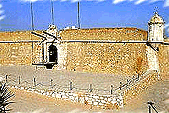 |
FORTALEZA DA PONTA DA BANDEIRA |
|
| This little fortress at the
southern end of Avenida dos Descobrimentos dates back to the
17th century. It was originally built to protect the port from
invasion, most likely from Francis Drake and his contemporaries. Today it is a museum tracing the history of Portuguese conquest and discovery and is a fascinating history of a time of aspiration, adventure and much cruelty in the name of wealth and religion. The museum is open from 10am to 1pm and 2pm to 6pm Tuesday to Saturday, and 10am to 1pm Sunday. |
||
|
|
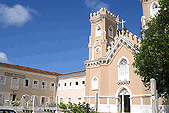 |
THE GOLDEN CHURCH OF SAN ANTONIO |
|
| This is Lagos’ main historical
attraction – the little Igreja de Santo Antonio. The dome and
the panelling were installed after the earthquake of 1755, which
flattened every building in the Algarve. The interior is an
inspiring array of gilded, carved wood depicting ripening grapes
and smiling cherubs in a baroque style. Access is from the adjacent Museu Municipal, which contains unusual artefacts such as 16th century grave markers, church robes and pickled foetuses. Opening hours are 9.30am to 12.30pm and 2pm to 5pm daily except Mondays. The church and museum are situated on Rua General Alberto Silveira, just south of the Praca da Republica. (Tel 282 762 301) |
||
|
|
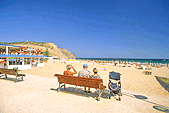 |
LUZ |
|
The village of Luz is an attractive, well established family resort in The Algarve, Portugal with a stylish modern marina, a good shopping area and a large number of restaurants, bars, cafés and shops. The village of Luz itself is a combination of quaint old cobbled whitewashed streets and modern facilities that cater for tourists. Luz is a few miles to the west of Lagos, and is also well known for its excellent wide sandy beach with some watersports. Literally translated, Praia da Luz means "Beach of Light" a name that is thought to date back to the time of the Moorish occupation. A beacon would be lit to warn fishermen at sea of the approaching danger from the savage Moors. Luz is still a typical Portuguese fishing village and the lights which can often be seen out to sea at night are from the boats fishing for squid. The lights, often strung out in a line across the sea, resemble the lights of a highway heading for Africa which is known locally as the "Road to Morocco". Further west one can visit typical Algarve fishing villages with good beaches such as Burgau Salema, several secluded beach coves and the dramatic Sagres peninsular. |
||
|
|
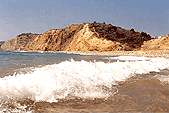 |
BURGAU |
|
Burgau is a peaceful Algarve village nestled on the edge of a national park, approximately 1 hour's drive from Faro Airport and located 10 minutes drive west of Lagos. The working fishing village of Burgau is a great place for soaking up the ambience of The Algarve and slowing down the pace on your villa holiday. The local economy is not wholly reliant on tourism, which means that Burgau, with its peaceful cobbled streets, retains its age-old personality. Most tourist facilities are available in Burgau. Visitors on their holiday can admire the colourful fishing boats and relax on the beautiful sandy beach. Those that enjoy walking there are some fantastic walks up the hill that is the backdrop to Burgau and coastal walks to Luz which is the next village or the other way to Salema. Lagos is the nearest town to Burgau, situated to the east. To the west is Vila do Bispo which has some good fish restaurants. Burgau sports centre offers squash, tennis, aerobics, etc. also Lagos offers further activities. For golf try Palmares Golf Course. |
||